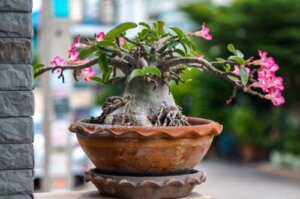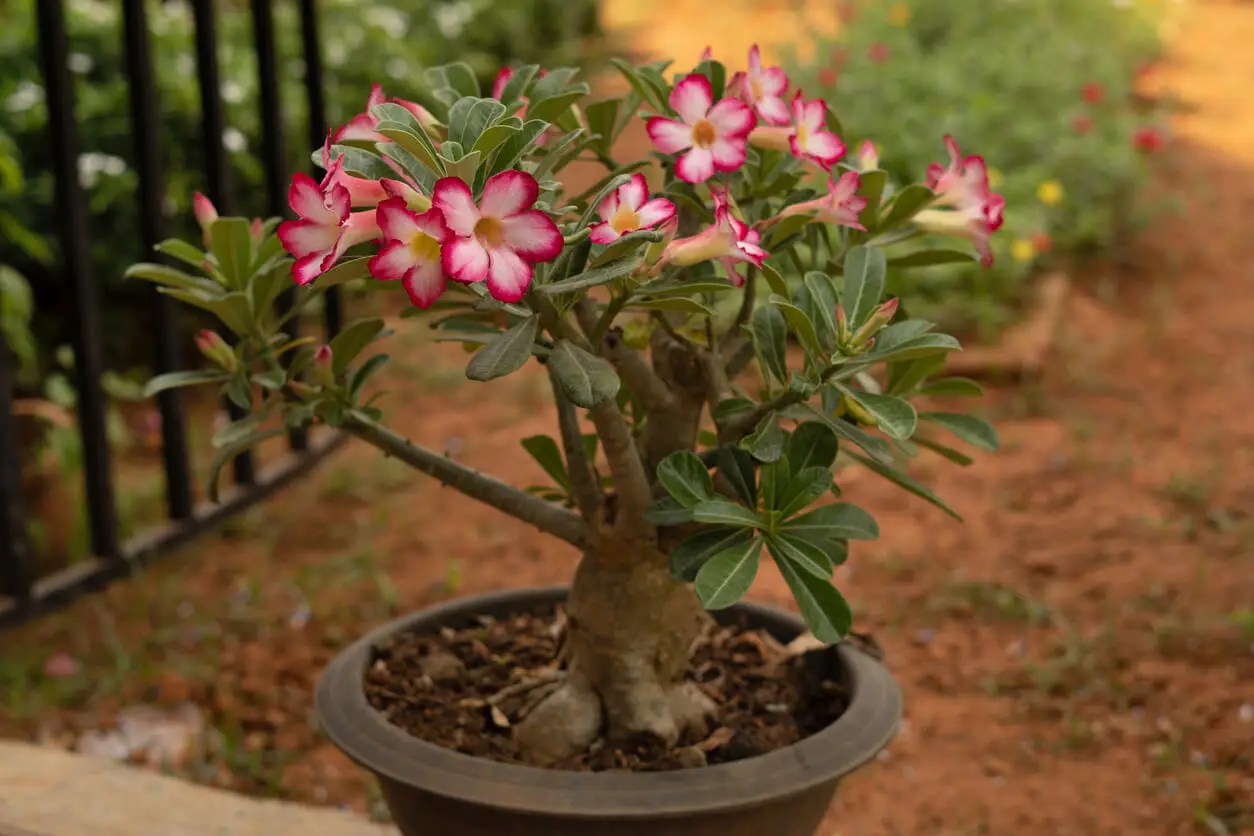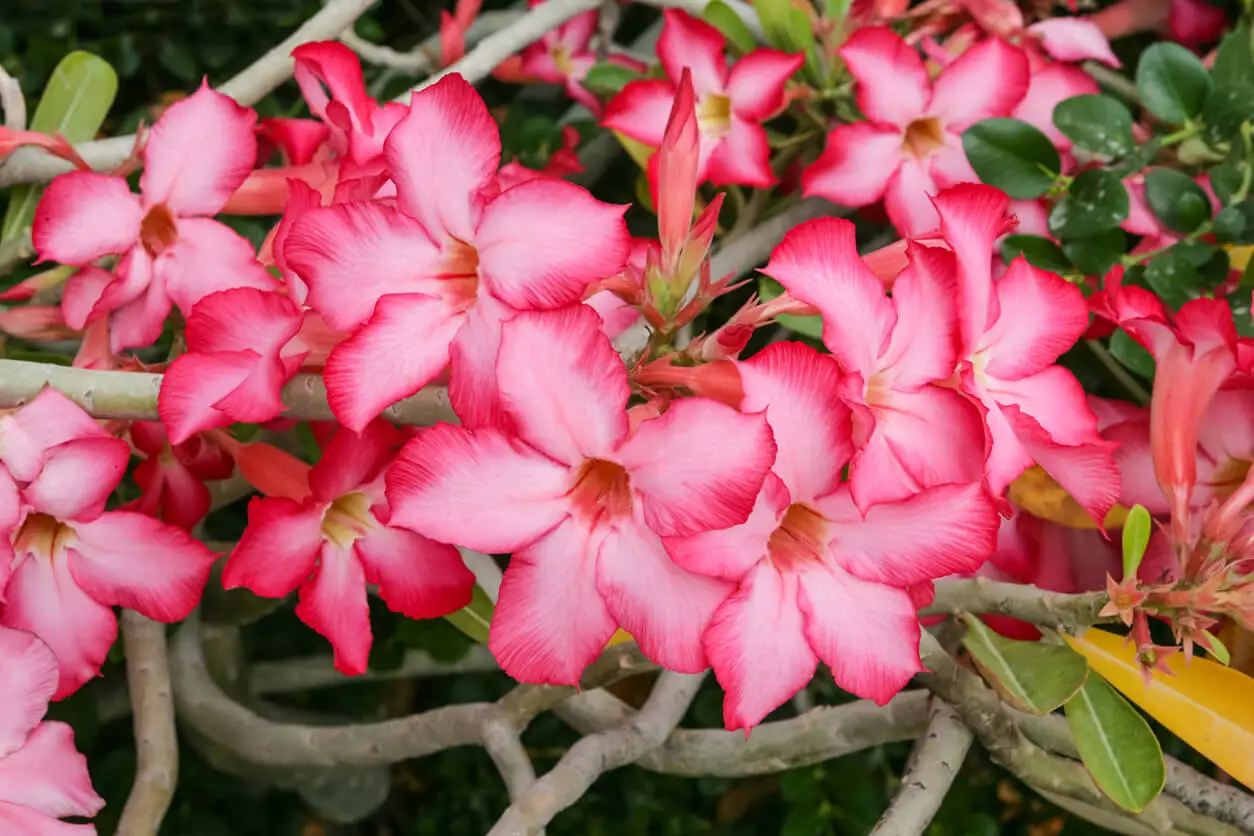Tips for Planting and Looking After the Desert Rose at Home

The desert rose is a species with abundant flowers that captivates with its unique appearance; its scientific name is Adenium obesum. It’s a type of mini-tree that produces flowers comparable to the shape of a trumpet.
The adaptive capacity of this plant allows it to thrive without problems in a pot, in a container, or using the bonsai technique. Although its delicacy alludes to special care needs, the truth is that it’s a succulent capable of surviving and showing off its best with just some basic care. Let’s take a look at what it needs.
The desert rose: a tender succulent
The desert rose used to be cultivated only in Africa, but today it can be found all over the world. Malaya Journal Biosciences catalogs it as an ornamental plant that goes beyond its decorative characteristics to provide benefits to science through its source of phytochemicals, useful in the pharmaceutical and fish farming industries.
The appearance of the species is that of a deciduous succulent, which can grow up to almost 2 meters tall (6.6 feet). You can plant it in a pot or container and “work” on it to keep it at the desired dimensions. The flowers vary in size and are pink, red or white.
The plant isn’t afraid of drought, because it stores water in its roots and thick trunk. However, it shows some wariness to cold periods, so during these times it’s appropriate to protect it in a warm room.

Recommendations for planting the desert rose
In pots arranged in the living room of the house, on the terrace, or directly in the garden, it’s possible to keep the plant quite easily. The way to plant it is by cuttings or seeds.
Cultivation by cuttings is considered the best way by the agro-technological curriculum Iskandar if you don’t want to wait a long time for the thickening of the stem and roots. The procedure is as follows.
- Choose some cuttings that are at least 6 inches long.
- Place them on a damp paper towel and let them rest in a dry, warm room away from direct sunlight.
- Prepare a pot with gravel and soil, ensuring optimal drainage. There you can plant the cuttings, not without first sprinkling the lower end with rooting powder.
- Water them every 2 days, without overwatering so as not to damage the roots.
- Transplant them if you wish.
When a desert rose is planted using seeds, you guarantee maximum development of the caudex, says specialist magazine Rural Science. The procedure is based on the steps listed below.
- Prepare a shallow pot, with 50% coconut fiber and 50% soil. You can substitute peat and perlite, respectively.
- Scatter the seeds in the substrate and fold them in with a blanket of sand.
- Sprinkle water every 2 days and, within a week, you will start to see sprouts.
- Change to an individual pot one month after planting.
Care tips for the desert rose
A desert rose that receives proper care becomes an eye-catching specimen for pollinators and hummingbirds. This is in addition to its elegance to the human eye. If you want your plant to be really attractive, take note of the recommendations we’ll now give you.
Fertilizer and substrate
Liquid or slow-release fertilizers are ideal for nourishing the plant. In spring, provide the plant with it once every 15 days; in summer, do it once a month. For the winter you don’t need to use fertilizer, because the rose is in dormancy.
As for the substrate, Ornamental Horticulture suggests choosing those that contribute to water retention and aeration. For the sprouting of seedlings, they suggest substrates based on semi-composted pine bark combined with coconut fiber.
Lighting
This kind of plant requires a lot of light, at least 6 hours a day. If you want to keep it inside the house, choose a window or place it next to the balcony.
Water
Adenium obesum likes rain and so it doesn’t do so badly in the rainy season. But when the weather is cool it isn’t necessary to water often. It’s a good option to water it every 2 weeks, because it helps to store water and prevents the soil from waterlogging.
Pruning
Pruning is the mechanism that controls the size of this mini-tree. Take advantage of the growing season to remove stubborn flower buds and the tips of the stems, as well as other areas that look damaged. Remember that healthy parts function as cuttings.

Transplanting
Changing from one pot to another is a task that’s done at least once every 2 to 3 years. This is because they’re slow-growing shrubs. Be careful not to overdo it with the size of the container, because you would give the roots room to expand too much and, paradoxically, this would affect the flowering.
Precautions when planting the desert rose
Adenium obesum is a relative of the Apocynaceae family. Therefore, it has certain toxicity emanating from its sap that is rich in cardiotonics. It’s recommended that the handling of the specimens be carried out with rubber gloves, especially when planting or pruning, as this will prevent irritation.
If there are pets at home or you live with children, it’s advisable to place the plant in a high area, so that any possible contact doesn’t result in a medical emergency.
In the least serious cases, there would be skin problems, diarrhea and vomiting. Other complications associated with the shrub are related to convulsions, as can happen in cases of intoxication caused by its “cousin”, the oleander.
All cited sources were thoroughly reviewed by our team to ensure their quality, reliability, currency, and validity. The bibliography of this article was considered reliable and of academic or scientific accuracy.
- Colombo, R. C., Da Cruz, M. A., De Carvalho, D. U., Hoshino, R. T., Alves, G. A. C., & De Faria, R. T. (2018). Adenium obesum as a new potted flower: Growth management. Ornamental Horticulture. Brazilian Society of Floriculture and Ornamental Plants. https://doi.org/10.14295/oh.v24i3.1226
- Díez Garretas, B., Asensi Díez, R. (s.f.). Plantas tóxicas en la flora ornamental de Málaga. Consultado el 31 de marzo de 2023. https://dialnet.unirioja.es/descarga/articulo/6442101.pdf
- Dipak, P., Karabi, B., Sankar Narayan, S. (2015). Biological Activities of Adenium obesum (Forssk.) Roem. & Schult.: A Concise Review. Malaya Journal of Biosciences, 2(4); 214-221. https://www.researchgate.net/publication/301847549_Biological_Activities_of_Adenium_obesum_Forssk_Roem_Schult_A_Concise_Review
- Iskandar (2019). Budidaya Adenium Obesum dengan Cara Stek dan Program Akar Adenium Obesum. Semantic Scholar. Consultado el 30 de marzo de 2023. https://www.semanticscholar.org/paper/Budidaya-Adenium-Obesum-dengan-Cara-Stek-dan-Akar-Iskandar/e4511a80c66b0011c2c81310a5f6a56d8aaaee9e
- Santiago Nogué, J., César, B., & Piqueras, J. (s.f.). Intoxicaciones por plantas y setas. Área Científica Menarini. Consultado el 31 de marzo de 2023. http://www.fetoc.es/asistencia/intoxicaciones_plantas_y_setas_completo_2009.pdf
- Santos, C. A., Loureiro, G. A. H. de A., Júnior, G. A. G., Pereira, R. A., Sodré, G. A., & Barbosa, R. M. (2020). Seed germination and development of desert rose seedlings (Adenium obesum roem. & schult) on different substrates. Ciencia Rural, 50(12), 1–7. https://doi.org/10.1590/0103-8478cr20190691
This text is provided for informational purposes only and does not replace consultation with a professional. If in doubt, consult your specialist.








